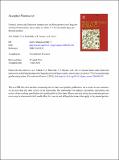Unusual, basin-scale, fluid-rock interaction in the Palaeoproterozoic Onega basin from Fennoscandia : preservation in calcite δ18O of an ancient high geothermal gradient
Abstract
A variety of carbonates of different geneses, as indicated by petrography and geochemistry, are found throughout 400m of the volcano-sedimentary rocks of the Zaonega Formation of Palaeoproterozoic age in the Onega Basin of Fennoscandia. Following intensive sampling and analysis of varied calcites from drillcore recovered during the ICDP FAR-DEEP program, we report a highly unusual depth distribution of calcite oxygen isotope values (δ18Ocal). Unprecedentedly for such rocks, the δ18Ocal values over the full depth interval of 400m are strongly linearly correlated with depth (r2 = 0.9015, n=178). We propose that this is the result of major oxygen isotope resetting through water-rock interaction with a fluid of relatively constant oxygen isotopic composition (δ18Ow). In this model, the observed linear δ18Ocal-depth relationship is then a consequence of the increase in temperature with depth because of the background geothermal gradient. Minor deviations from the overall linear trend are likely due to bed-scale geological factors including locally high impermeability, and oxygen isotope modification of δ18Ow by comparatively intense water-rock interaction. Were the observed δ18Ocal values to have been reset during the greenschist facies Svecofennian metamorphism which affected the rocks at c. 1800Ma, the implied geothermal gradient of ∼ 560°C km-1 is geologically unreasonable and, accordingly, this hypothesis is ruled out. Rather, the δ18Ocal variation of 5‰ over 400m implies a near-surface depth for the rocks during fluid interaction, and this is consistent with a surface-derived origin of the infiltrating fluid (δ18Ow ∼ -13.6‰ for a surface temperature of 15°C and geothermal gradient of ∼ 52 °C km-1). It is speculated that the fluid accessed the carbonates from the basin edge by bed-parallel rather than cross-formational flow. There is an intriguing distribution of Na in the sedimentary rocks of the Zaonega Formation. Sodium is relatively abundant in rocks below a certain depth (the Lowermost Dolostone at ∼258m), but rare in shallower sequences. It is argued that this distribution did not originate with the basin-scale fluid-rock interaction documented above, but may rather be the result of evaporite dissolution, and subsequent redistribution of soluble elements during fluid flow associated with the syndepositional emplacement of basin-wide igneous rocks.
Citation
Fallick , A E , Melezhik , V A , Brasier , A T & Prave , A R 2016 , ' Unusual, basin-scale, fluid-rock interaction in the Palaeoproterozoic Onega basin from Fennoscandia : preservation in calcite δ 18 O of an ancient high geothermal gradient ' , Precambrian Research , vol. 281 . https://doi.org/10.1016/j.precamres.2016.06.001
Publication
Precambrian Research
Status
Peer reviewed
ISSN
0301-9268Type
Journal article
Description
The authors acknowledge financial support from ICDP for the drilling programme. AEF, ATB and ARP thank NERC for financial support through NE/G00398X/1. VAM, AEC, and AL thank the Norwegian Research Council for financial support through 191530/V30.Collections
Items in the St Andrews Research Repository are protected by copyright, with all rights reserved, unless otherwise indicated.

